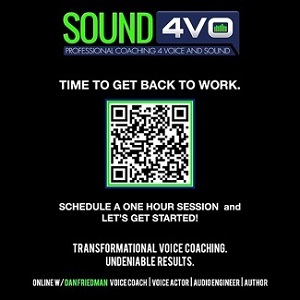|
ASK MARC #4: Do I Ask New Client For Deposit? Is Quality Of My Studio Audio OK?  By Marc Cashman Voice Actor & Coach ©Marc Cashman 2012 This is a monthly Q&A column on VoiceOverXtra, where I answer a veritable smorgasbord of voice over questions. If you'd like to pop a question to me, please see my contact info below. @ Billing Your Clients Q: Hey Marc, is it customary to ask for a deposit before you voice a job - even if the company that hired you has a website and is known? I asked for one because I have been burned in the past. But those were people who just found me randomly on the Internet, had a Gmail account and no website. Your thoughts? -Wendy B., Tampa, FL A: Great question, Wendy. I have no problem with asking for a nominal good faith deposit from someone or some company youíve never worked with before. It can be stipulated in a simple letter of agreement. 25% is usually the standard deposit for a project, but that figure is ultimately up to you. After youíve established (hopefully) an on-going working relationship with the company, youíll just be able to send them an invoice upon completion of the project. But also stipulate the billing cycle: 15 days, 30 days, 45 or 60. I donít think any job should be paid outside of 60 days. @ Testing Audio Quality Q: I have finally constructed and equipped my home studio and I've created some test sound. (Attached.) I want to send it to pros in the biz who have generously taken time to answer my questions. I'm also sending it to a couple of audio engineers I've worked with in radio for their take. I'm close to launching my career, but don't want to do it until I know I've got good sound and understand the technicalities of sending files. Any advice or thoughts always appreciated. - Jay L., Austin, TX A: Jay, Iím not an audio engineer, so Iím sending you the advice of the man who built my studio - Mike Sommer. Hereís his take ... Jay, I'm not sure where you got your recording studio information, but perhaps you've misinterpreted that advice. First, your audio quality is poor. If you were to submit an audition with the sound quality you have now, it would be rejected simply because of the quality. 1. Your noise floor is too high. I hear your computer, and or some other kind of motor, along with some unidentifiable ambient noise. 2. Room resonance. Your little box is knocking down some of the roomís resonance. On the other hand, it is creating it's own resonance. There is also a great deal of reflection (echo) - I can hear a reflection coming from the back wall. 3. The mic and interface are not doing you justice. I would suggest a Studio Projects C1, and a good all-in-one preamp like a DBX 268A. 4. Acoustics problem. Your misinterpretation of acoustics has led you to create a foam -covered resonating chamber. And it does not provide isolation, because it is open at one end. It also cannot provide adequate sound treatment because the foam you use is an open-cell foam. Open cell foam does not provide the absorption of sound that closed cell foam provides. MUST ISOLATE ROOM The idea of your box is not new. It originally used a milk crate and Auralex foam inside of it. What makes this so special is that it reduces near-field reflections to the microphone, and reduced modal build up of the bass frequencies to some extent. But it still does not provide isolation. To provide isolation you need mass, distance and air fastness. And isolation often requires sealing off an entire room, or in some situations, a closet. Simply building an open-end box will not provide this; even WhisperRooms do not provide isolation. TEST FOR NOISES The best thing you can do is find out what noise you can hear in your recording area by setting up you mic in the room and just record the room. Then identify the noises that you hear, and eliminate them. If noise is coming from a window you'll need to seal it. If noise is coming through or around a door, you need to install a denser door and/or seal with exterior door seals. It's also advisable to turn on everything in the house to discover what can and cannot be heard in your recording area. Foot falls and noise coming through walls require more drastic measures, such as floating floors and additional layers of drywall, or Quiet Rock. If you can get a truly quiet room, you can then treat the walls with ridged fiberglass insulation such as Owens Corning 703, or JohnManvilleís ISUL-Shield. Placing cloth covered panels on the walls and ceiling, and bass traps in the corners, will eliminate the reflections in your room, and reduce the build up of bass, which adds muddiness to sound, and hence give focus to the voice. LEARN OR GET CONSULTANT There is so much more to know and understand in regards to isolation and treatment, and going cheap will end up costing you more than doing it right the first time. If you are going to continue DIY solutions, then I would suggest getting Home Recording Studio, Build it like the Pros by Rod Gervais. This book, though more than you may need, will give you a better understanding as to what is needed in terms of true studio construction. Otherwise spend the money and hire a consultant who can treat your room properly. Good luck! Post script from Marc: Sadly, Mike passed away at the end of 2011. Above is a letter that he generously answered a couple of months before then. ABOUT MARC ... Marc Cashman creates and produces copy and music advertising for radio and television. Winner of over 150 advertising awards, he also instructs voice acting of all levels through his classes, The Cashman Cache of Voice-Acting Techniques in Los Angeles. Email: cashcomm@earthlink.net Web: www.cashmancommercials.com |
|
|
Tell Us What YOU Think!
Please Note: Since we check for spam, there will be a slight delay in the actual posting of your comment.
Comments (3)
George Whittam
4/23/2012 at 3:24 AM
Mike really knew his stuff, and I learned a lot about acoustics from him. I and others like Dan Lenard carry the batton of home studio consultancy so that VO's don't make the same mistakes made by so many others before them. I provide free audio evaluations through my dropbox, should anyone need any feedback on their audio quality. Visit vostudiotech.com and click on Dropbox to get started.
Marc Cashman
4/20/2012 at 6:05 PM
Robert, you're absolutely right: the way to understand Mike's advice better would be to hear exactly what's going on and be able to see the space. That part of my column was mainly a remembrance of Mike Sommer, a master craftsman who designed and built my beautiful home studio. What I hoped the reader would take away from that letter and response was a basic understanding of the terminology and concepts that go into creating the ideal acoustics for voice over recording. And that if they were thinking of investing in a professional home studio setup, they'd better know what to do or find someone to do it - right. Mike was hired as a consultant in commercial studios as well as home studios, and yes, it sounded a bit self-serving, but I think if you're able to find someone reputable, it's a small investment to make for a somewhat expensive setup, particularly if you don't know what you're doing (like me). And boy, do I wish he were still around to share his knowledge.
Robert
4/20/2012 at 12:36 AM
This is not helpful at all. no one can hear what Jay submitted. we don't know what equipment he has or where he made the recording. he might have done it in his laundry room with the dryer turned on and with a crappy laptop and bad software. and to conclude that you should hire a consultant is totally self serving advice. I am sorry Mike is not able to respond because I am sure he could provide a more complete response.



.png)






click for new article alerts